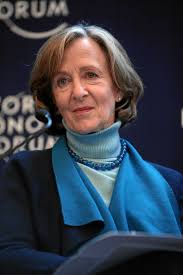
Creative Commons
A Franke Program event Monday discussed how science and technology can help manage the exponentially increasing global population.
On March 1, the Franke Program in Science and the Humanities hosted Susan Hockfield, professor of neuroscience at the Massachusetts Institute of Technology, for a talk entitled “The Age of Living Machines: How Biology Will Build the Next Technology Revolution,” as part of the program’s distinguished speaker series. Hockfield’s talk centered on how the convergence of biology and engineering would help solve current and future world issues.
Hockfield, who served as MIT’s first female president and Yale provost before stepping into her current role, spoke about ideas from her book published in 2019, which has the same title as yesterday’s talk.
“I had [a] breathtaking perspective of science and technology frontiers [as MIT’s president],” Hockfield said. “The future I saw was frankly astonishing.”
One issue that Hockfield brought up was the skyrocketing world population, which is estimated to surpass 9.7 billion people by 2050. She highlighted challenges including providing cheap and effective healthcare to the global community and producing enough sustainable energy, clean water and nutritious food — challenges, she pointed out, that the world already struggles with at current population levels.
She framed these problems as expressions of the Malthusian dilemma, which predicts what Hockfield called a “Malthusian crisis” — when available resources are no longer sufficient to support the human population.
In other words, if we do not meet the demands of almost 10 billion people, Hockfield assessed, “we can anticipate chaos.”
Hockfield continued on to say that fortunately, discovery and innovation has helped humans “defeat” Malthus before. She highlighted contemporary society’s rapid technological progress, a product of the 20th century convergence of physics and engineering, as an example. But “to defeat Malthus again, we need to innovate,” Hockfield said.
“In media consumed by the public, limiting population growth has always been the most emphasized solution [to inadequate resource production],” attendee Emily He ’24 said. “I think it’s refreshing that Professor Hockfield’s presentation emphasized increasing the efficiency of production [as an alternative.]”
At the talk, Hockfield said that a deeper understanding of molecular biology and the
“parts list of the biological world” — fundamental units of biology, such as DNA, RNA and proteins — will help us support the human population.
Hockfield also noted that engineers are currently using the “parts list” to build new transformative technologies. She cited innovations in early and effective disease detection by Sangeeta Bhatia, professor of engineering at MIT, and new techniques for creating biodegradable battery casings by Angela Belcher, professor of biological engineering and materials science at MIT, as examples.
“In a similar vein, I see an analogous grand convergence in my own field of research — astronomy & astrophysics,” Priyamvada Natarajan, professor of astronomy and the director of the Franke Program, wrote in an email to the News. “In the past two decades, we have had a similar confluence of three elements … This grand ‘convergence’ has opened up discovery space — and we are witnessing that now — so I totally get what she envisions for the future — the far-reaching transformations that the convergence of technology and biology are setting up in motion now.”
Hockfield ended the talk by emphasizing the importance of institutional promotion of collaborative, cross-discipline research. She also advocated for federal investment into basic research.
The Franke Program’s Distinguished Speaker series will host Alan Mikhail, professor of history, for its next event on March 24.
Keenan Miller | keenan.miller@yale.edu







